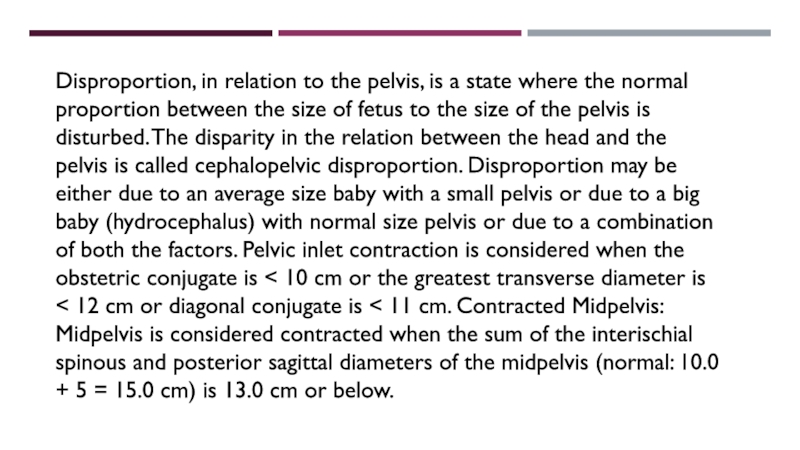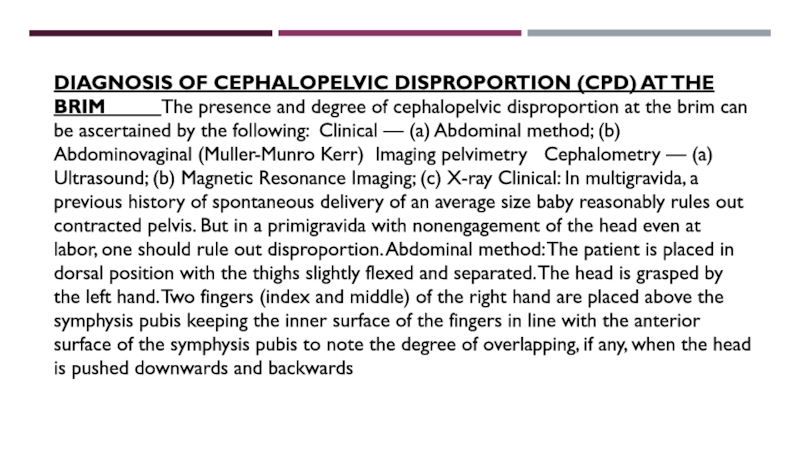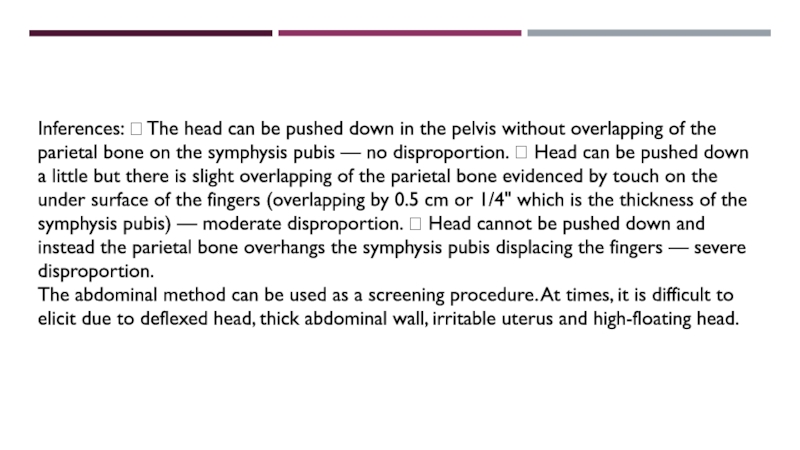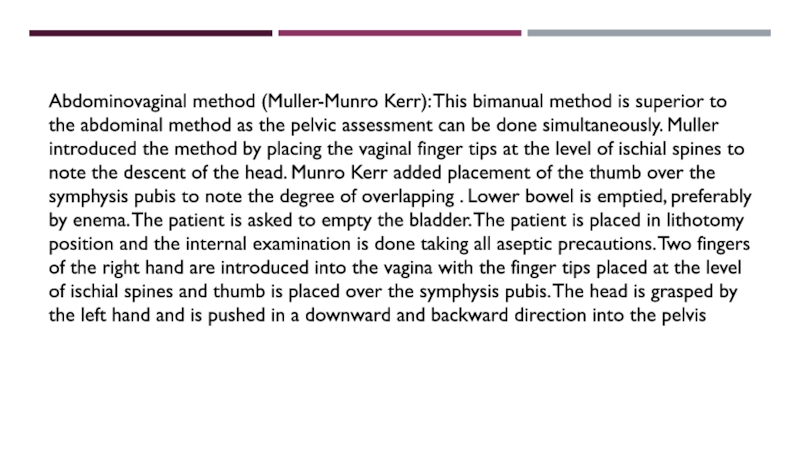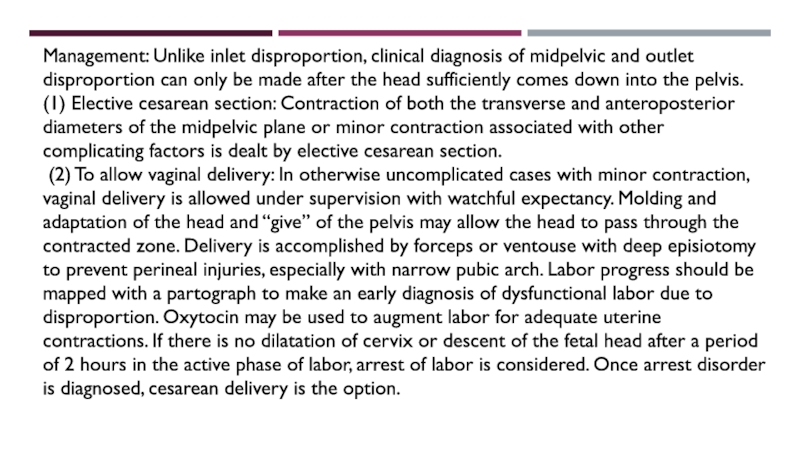Разделы презентаций
- Разное
- Английский язык
- Астрономия
- Алгебра
- Биология
- География
- Геометрия
- Детские презентации
- Информатика
- История
- Литература
- Математика
- Медицина
- Менеджмент
- Музыка
- МХК
- Немецкий язык
- ОБЖ
- Обществознание
- Окружающий мир
- Педагогика
- Русский язык
- Технология
- Физика
- Философия
- Химия
- Шаблоны, картинки для презентаций
- Экология
- Экономика
- Юриспруденция
Cephalopelvic disproportion
Содержание
- 1. Cephalopelvic disproportion
- 2. Disproportion, in relation to the pelvis, is
- 3. Contracted outlet is suspected when the interischial
- 4. As the head is the largest part
- 5. DIAGNOSIS OF CEPHALOPELVIC DISPROPORTION (CPD) AT THE
- 6. Inferences: The head can be pushed
- 7. Abdominovaginal method (Muller-Munro Kerr): This bimanual method
- 8. Inferences: (1) The head can be pushed
- 9. X-ray pelvimetry: Lateral X-ray view with the
- 10. Degree of disproportion and contracted pelvis: Based
- 11. Management: Unlike inlet disproportion, clinical diagnosis of
- 12. Слайд 12
- 13. Скачать презентанцию
Disproportion, in relation to the pelvis, is a state where the normal proportion between the size of fetus to the size of the pelvis is disturbed. The disparity in the relation
Слайды и текст этой презентации
Слайд 1Cephalopelvic disproportion
Teacher ; KAMILOVA IRINA KAHAROVNA
BY
RAMALINGAM LOKESWARAN
GROUP;LA1-C-O-163(2)
Слайд 2Disproportion, in relation to the pelvis, is a state where
the normal proportion between the size of fetus to the
size of the pelvis is disturbed. The disparity in the relation between the head and the pelvis is called cephalopelvic disproportion. Disproportion may be either due to an average size baby with a small pelvis or due to a big baby (hydrocephalus) with normal size pelvis or due to a combination of both the factors. Pelvic inlet contraction is considered when the obstetric conjugate is < 10 cm or the greatest transverse diameter is < 12 cm or diagonal conjugate is < 11 cm. Contracted Midpelvis: Midpelvis is considered contracted when the sum of the interischial spinous and posterior sagittal diameters of the midpelvis (normal: 10.0 + 5 = 15.0 cm) is 13.0 cm or below.Слайд 3Contracted outlet is suspected when the interischial tuberous diameter is
8 cm or less. A contracted outlet is often associated
with midpelvic contraction. Isolated outlet contraction is a rarity Disproportion at the outlet may not give rise to severe dystocia, but may cause perineal tears. The head is pushed backwards as it cannot be accommodated beneath the symphysis pubis.
Слайд 4As the head is the largest part of the fetus,
it is more important to know whether the greatest diameter
of the head passes through the different planes of the pelvis. Thus, from the clinical point of view, identification of the cephalopelvic disproportion is more logical than to concentrate entirely on the measurements of a given pelvis, as the fetal head is the best pelvimeter. Thus, disproportion may be limited to one or more planes. Absence of cephalopelvic disproportion at the brim usually, but not always, negates its presence at the midpelvic plane. On the other hand, isolated outlet contraction without midpelvic contraction is a rarity. Thus, a thorough assessment of the pelvis and identification of the presence and degree of cephalopelvic disproportion are to be noted while evaluating a case of contracted pelvisСлайд 5DIAGNOSIS OF CEPHALOPELVIC DISPROPORTION (CPD) AT THE BRIM
The presence and degree of cephalopelvic disproportion at
the brim can be ascertained by the following: Clinical — (a) Abdominal method; (b) Abdominovaginal (Muller-Munro Kerr) Imaging pelvimetry Cephalometry — (a) Ultrasound; (b) Magnetic Resonance Imaging; (c) X-ray Clinical: In multigravida, a previous history of spontaneous delivery of an average size baby reasonably rules out contracted pelvis. But in a primigravida with nonengagement of the head even at labor, one should rule out disproportion. Abdominal method: The patient is placed in dorsal position with the thighs slightly flexed and separated. The head is grasped by the left hand. Two fingers (index and middle) of the right hand are placed above the symphysis pubis keeping the inner surface of the fingers in line with the anterior surface of the symphysis pubis to note the degree of overlapping, if any, when the head is pushed downwards and backwardsСлайд 6Inferences: The head can be pushed down in the
pelvis without overlapping of the parietal bone on the symphysis
pubis — no disproportion. Head can be pushed down a little but there is slight overlapping of the parietal bone evidenced by touch on the under surface of the fingers (overlapping by 0.5 cm or 1/4" which is the thickness of the symphysis pubis) — moderate disproportion. Head cannot be pushed down and instead the parietal bone overhangs the symphysis pubis displacing the fingers — severe disproportion.The abdominal method can be used as a screening procedure. At times, it is difficult to elicit due to deflexed head, thick abdominal wall, irritable uterus and high-floating head.
Слайд 7Abdominovaginal method (Muller-Munro Kerr): This bimanual method is superior to
the abdominal method as the pelvic assessment can be done
simultaneously. Muller introduced the method by placing the vaginal finger tips at the level of ischial spines to note the descent of the head. Munro Kerr added placement of the thumb over the symphysis pubis to note the degree of overlapping . Lower bowel is emptied, preferably by enema. The patient is asked to empty the bladder. The patient is placed in lithotomy position and the internal examination is done taking all aseptic precautions. Two fingers of the right hand are introduced into the vagina with the finger tips placed at the level of ischial spines and thumb is placed over the symphysis pubis. The head is grasped by the left hand and is pushed in a downward and backward direction into the pelvisСлайд 8Inferences: (1) The head can be pushed down up to
the level of ischial spines and there is no overlapping
of the parietal bone over the symphysis pubis — no disproportion; (2) The head can be pushed down a little but not up to the level of ischial spines and there is slight overlapping of the parietal bone — slight or moderate disproportion; (3) The head cannot be pushed down and instead the parietal bone overhangs the symphysis pubis displacing the thumb — severe disproportion.Limitations of clinical assessment: (1) The method is only applicable to note the presence or absence of disproportion at the brim and not at all applicable to elicit midpelvic or outlet contraction; (2) The fetal head can be used as a pelvimeter to elicit only the contraction in the anteroposterior plane of the inlet but when the contraction affects the transverse diameter of the inlet, it is of less use
Слайд 9X-ray pelvimetry: Lateral X-ray view with the patient in standing
position is helpful in assessing cephalopelvic proportion in all planes
of the pelvis — inlet, midpelvic and outlet.Cephalometry: While a rough estimation of the size of the head can be assessed clinically, accurate measurement of the biparietal diameter would have been ideal to elicit its relation with the diameters of the planes of a given pelvis through which it has to pass. In this respect, ultrasonographic measurement of the biparietal diameter or Magnetic Resonance Imaging (MRI) gives superior information. The average biparietal diameter measures 9.4–9.8 cm at term.
Magnetic Resonance Imaging (MRI): MRI is useful to assess the pelvic capacity at different planes. It is equally informative to assess the fetal size, fetal head volume and pelvic soft tissues which are also important for successful vaginal delivery.
Слайд 10Degree of disproportion and contracted pelvis: Based on the clinical
and supplemented by imaging pelvimetry, the following degrees of disproportion
at the brim are evaluated: (1) Severe disproportion: Where obstetric conjugate is < 7.5 cm (3"). Such type is rare to see. (2) Borderline:Where obstetric conjugate is between 9.5 cm and 10 cm. When both the anteroposterior diameter (< 10 cm) and the transverse diameter (< 12 cm) of the inlet are reduced, the risk of dystocia is high than when only one diameter is contractedСлайд 11Management: Unlike inlet disproportion, clinical diagnosis of midpelvic and outlet
disproportion can only be made after the head sufficiently comes
down into the pelvis. (1) Elective cesarean section: Contraction of both the transverse and anteroposterior diameters of the midpelvic plane or minor contraction associated with other complicating factors is dealt by elective cesarean section.(2) To allow vaginal delivery: In otherwise uncomplicated cases with minor contraction, vaginal delivery is allowed under supervision with watchful expectancy. Molding and adaptation of the head and “give” of the pelvis may allow the head to pass through the contracted zone. Delivery is accomplished by forceps or ventouse with deep episiotomy to prevent perineal injuries, especially with narrow pubic arch. Labor progress should be mapped with a partograph to make an early diagnosis of dysfunctional labor due to disproportion. Oxytocin may be used to augment labor for adequate uterine contractions. If there is no dilatation of cervix or descent of the fetal head after a period of 2 hours in the active phase of labor, arrest of labor is considered. Once arrest disorder is diagnosed, cesarean delivery is the option.

